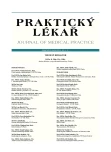-
Medical journals
- Career
Basics of social cognitive and affective neuroscience.
II. Empathy
Authors: F. Koukolík
Authors‘ workplace: Primář: MUDr. František Koukolík, DrSc. ; Národní referenční laboratoř prionových chorob ; Fakultní Thomayerova nemocnice s poliklinikou, Praha ; Oddělení patologie a molekulární medicíny
Published in: Prakt. Lék. 2011; 91(2): 63-67
Category: Editorial
Overview
Empathy is a shared interpersonal experience with components of
– affective arousal,
– emotion understanding, and
– emotion regulation.
Every component has its evolutionary and ontogenetic trajectory. Empathy is a function, which involves a distributed recursively connected neuronal network consisting of medial prefrontal, orbitofrontal, insular and cingular cortices and their connections with amygdala and systems of regulation of autonomic and neuroendocrine responses.Empathy is a fundamental trait of humanness.
Key words:
empathy, distributed neuronal network, affective arousal, emotion understanding, emotion regulation.
Sources
1. Ali, F., Amorim, I.S., Chamorro-Premuzic, T. Empathy deficits and trait emotional intelligence in psychopathy and machiavelianism. Pers. Individ. Di., 2009, 47, p. 758-762.
2. Baron-Cohen, S. The empathizing system. A revision of the 1994 model of the Mindreading system. In: Ellis., Bjorklund D. Origins of the social mind. New York: Guilford 2005, p. 468-492.
3. Bufalari, I., Aprile, T., Avenante, A. et al. Empathy for pain and touch in the human somatosensory cortex. Cerebral. Cortex. 2007, 17, p. 2553-2561.
4. Dapretto, M., Davies, M.S., Pfeifer, J.H. et al. Understanding emotion in others: Mirror neuron dysfunction in children with autism spectrum disorders. Nature Neuroscience 2006, 9, p. 28-30.
5. Darwin, C. The descent of man, and selection in relation to sex. Princeton, NJ: Princeton University Press 1982 (1871).
6. Decety, J., Meyer, M. From emotion resonance to empathic understanding: a social developmental account. Dev. Psychopathol. 2008, 20, p. 1053-1080.
7. Decety, J., Echols, S., Correll, J. The blame game: the effect of responsibility and social stigma on empathy for pain. J. Cognitive Neuroscience 2009, 22, p. 985-997.
8. Decety, J. The neurodevelopment of empathy in humans. Dev. Neurosci. 2010; doi: 10.1159/00317771.
9. De Vignemont, F., Singer, T. The empathic brain: how, when and why? Trends Cogn. Sci. 2006, 10, p. 435-441.
10. De Waal, F.BM. Putting altruism back into altruism: the evolution of empathy. Annu. Rev. Psychol. 2008, 59, p. 279-300.
11. Hooker, C.H.I., Verosky, S,C., Germine, L.T. et al. Neural activity during signal perception correlates with self-reported empathy. Brain Res. 2010, 1308, p. 100-113.
12. Koukolík, F., Drtilová, J. Vzpoura deprivantů. Nové vydání. Praha: Galén, 2006.
13. Koukolík, F. Před úsvitem, po ránu. Eseje o dětech a rodičích. Praha: Karolinum, 2008, 200 s.
14. Koukolík, F. Mentalizace. Prakt. Lék. 2008, 88, s. 566-571.
15. Koukolík, F. Lidství. Neuronální koreláty. Praha: Galén, 2010, s. 45-54.
16. Masserman, J., Wechkin, M.S., Terris, W. Altruistic behavior in rhesus monkeys. Am. J. Psychiatry 1964, 121, p. 584-585.
17. Mathur, V.A., Harada, T., Lipke, T. et al. Neural basis of extraordinary empathy and altruistic motivation. NeuroImage 2010, 51, p. 1468-1475.
18. O’Conell, S.M.. Empathy in chimpanzees: evidence for theory of mind? Primates 1995, 36, p. 397-410.
19. Ochsner, K.N., Zaki, J., Hanelin, J. et al. Your pain or mine? Common and distinct neural systems supporting the perception of pain in self and other. SCAN 2008, 3, p. 144-160.
20. Preston, S.D., de Waal, F.BM. Empathy: its ultimate and proximate bases. Behav. Brain Sci. 2002, 25, p. 1-72.
21. Rameson, L.T., Lieberman, M.D. Empathy: a social cognitive neuroscience approach. Soc. Personal. Psychol. Compass. 2009, 3/1, p. 94-110.
22. Shamay-Tsoory, S.G., Aharon-Peretz, J. Perry, D. Two systems for empathy: a double dissociation between emotional and cognitive empathy in inferior frontal gyrus versus ventromedial prefrontal lesions. Brain 2008, doi:10 : 1093/brain/awn279.
23. Singer, T., Seymour, B., O’Doherty, J.O. et al. Empathy for pain involves the affective but not sensory components of pain. Science 2004, 303, p. 1157-1161.
24. Singer, T., Seymour, B., O’Doherty, J.O. et al. Empathic neural response are modulated by the perceived fairness of others. Nature 2006, 439, p. 466-469.
Labels
General practitioner for children and adolescents General practitioner for adults
Article was published inGeneral Practitioner

2011 Issue 2-
All articles in this issue
-
Basics of social cognitive and affective neuroscience.
II. Empathy - Passive smoking and otitis media
- Antiaggregation treatment – review of drugs, importance for clinical practice, and possibilities of determination of resistance to treatment
- Diabetes mellitus of 2. type – vascular disease
- Autoimmune haemolytic anaemias
- Langhammer P.: Prenatal diagnostics of inborn defects in the Czech republic: up-to-date data
- Pulmonary embolism as a paraneoplastic symptom of choroid melanoma
- Thrombosis in patient with lupus nephritis
- Fats – metaanalyses, new recommended rations, news in legislation 2009/2010
- Occupational health aspects of manufactured nanomaterials
- The Internet, addictive substances and gambling
-
Basics of social cognitive and affective neuroscience.
- General Practitioner
- Journal archive
- Current issue
- Online only
- About the journal
Most read in this issue- Antiaggregation treatment – review of drugs, importance for clinical practice, and possibilities of determination of resistance to treatment
- Autoimmune haemolytic anaemias
-
Basics of social cognitive and affective neuroscience.
II. Empathy - Pulmonary embolism as a paraneoplastic symptom of choroid melanoma
Login#ADS_BOTTOM_SCRIPTS#Forgotten passwordEnter the email address that you registered with. We will send you instructions on how to set a new password.
- Career
